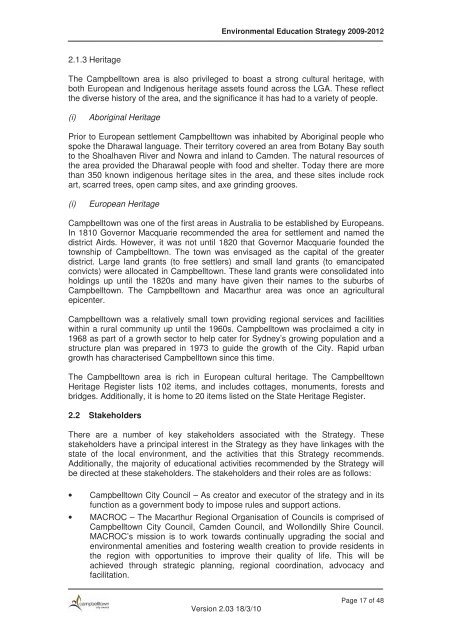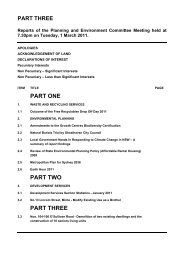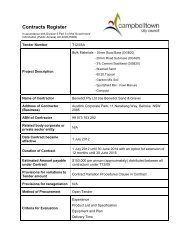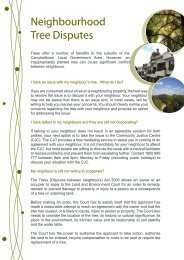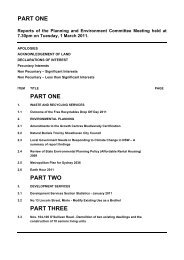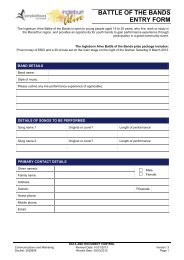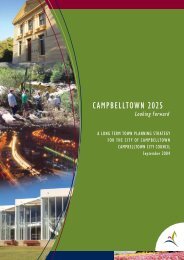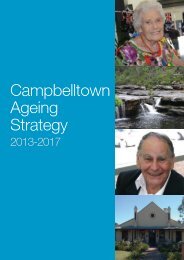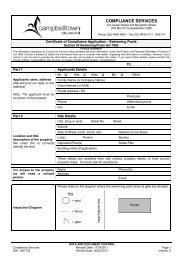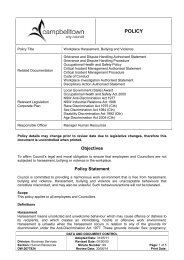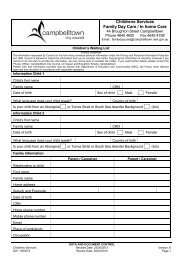Environmental Education Strategy - Campbelltown City Council ...
Environmental Education Strategy - Campbelltown City Council ...
Environmental Education Strategy - Campbelltown City Council ...
- No tags were found...
Create successful ePaper yourself
Turn your PDF publications into a flip-book with our unique Google optimized e-Paper software.
<strong>Environmental</strong> <strong>Education</strong> <strong>Strategy</strong> 2009-20122.1.3 HeritageThe <strong>Campbelltown</strong> area is also privileged to boast a strong cultural heritage, withboth European and Indigenous heritage assets found across the LGA. These reflectthe diverse history of the area, and the significance it has had to a variety of people.(i)Aboriginal HeritagePrior to European settlement <strong>Campbelltown</strong> was inhabited by Aboriginal people whospoke the Dharawal language. Their territory covered an area from Botany Bay southto the Shoalhaven River and Nowra and inland to Camden. The natural resources ofthe area provided the Dharawal people with food and shelter. Today there are morethan 350 known indigenous heritage sites in the area, and these sites include rockart, scarred trees, open camp sites, and axe grinding grooves.(i)European Heritage<strong>Campbelltown</strong> was one of the first areas in Australia to be established by Europeans.In 1810 Governor Macquarie recommended the area for settlement and named thedistrict Airds. However, it was not until 1820 that Governor Macquarie founded thetownship of <strong>Campbelltown</strong>. The town was envisaged as the capital of the greaterdistrict. Large land grants (to free settlers) and small land grants (to emancipatedconvicts) were allocated in <strong>Campbelltown</strong>. These land grants were consolidated intoholdings up until the 1820s and many have given their names to the suburbs of<strong>Campbelltown</strong>. The <strong>Campbelltown</strong> and Macarthur area was once an agriculturalepicenter.<strong>Campbelltown</strong> was a relatively small town providing regional services and facilitieswithin a rural community up until the 1960s. <strong>Campbelltown</strong> was proclaimed a city in1968 as part of a growth sector to help cater for Sydney’s growing population and astructure plan was prepared in 1973 to guide the growth of the <strong>City</strong>. Rapid urbangrowth has characterised <strong>Campbelltown</strong> since this time.The <strong>Campbelltown</strong> area is rich in European cultural heritage. The <strong>Campbelltown</strong>Heritage Register lists 102 items, and includes cottages, monuments, forests andbridges. Additionally, it is home to 20 items listed on the State Heritage Register.2.2 StakeholdersThere are a number of key stakeholders associated with the <strong>Strategy</strong>. Thesestakeholders have a principal interest in the <strong>Strategy</strong> as they have linkages with thestate of the local environment, and the activities that this <strong>Strategy</strong> recommends.Additionally, the majority of educational activities recommended by the <strong>Strategy</strong> willbe directed at these stakeholders. The stakeholders and their roles are as follows:• <strong>Campbelltown</strong> <strong>City</strong> <strong>Council</strong> – As creator and executor of the strategy and in itsfunction as a government body to impose rules and support actions.• MACROC – The Macarthur Regional Organisation of <strong>Council</strong>s is comprised of<strong>Campbelltown</strong> <strong>City</strong> <strong>Council</strong>, Camden <strong>Council</strong>, and Wollondilly Shire <strong>Council</strong>.MACROC’s mission is to work towards continually upgrading the social andenvironmental amenities and fostering wealth creation to provide residents inthe region with opportunities to improve their quality of life. This will beachieved through strategic planning, regional coordination, advocacy andfacilitation.Version 2.03 18/3/10Page 17 of 48


